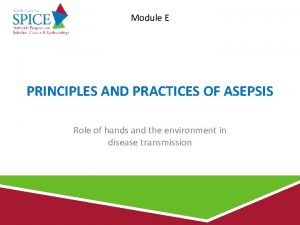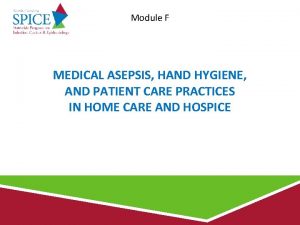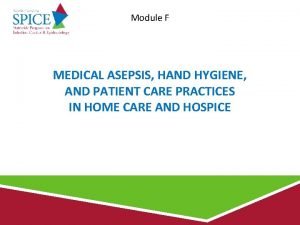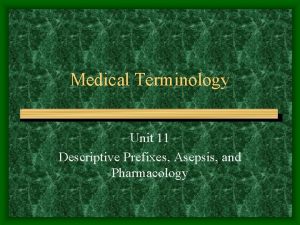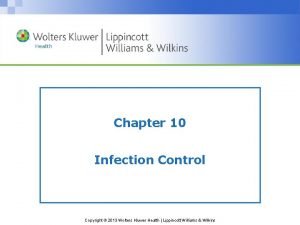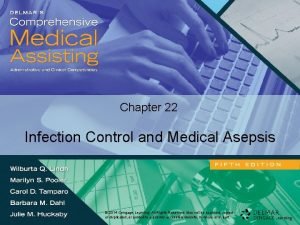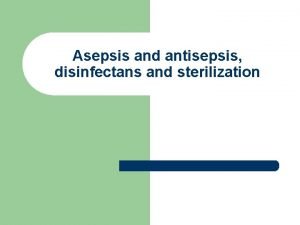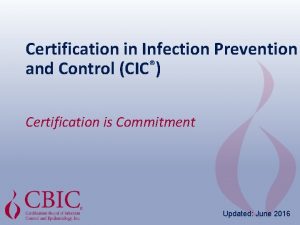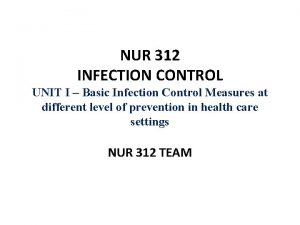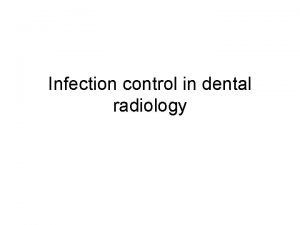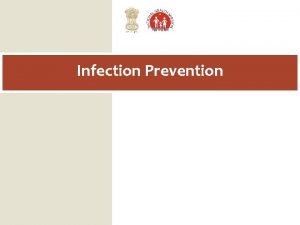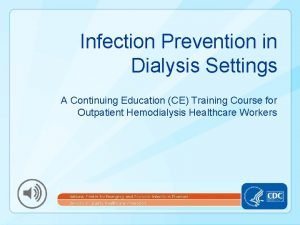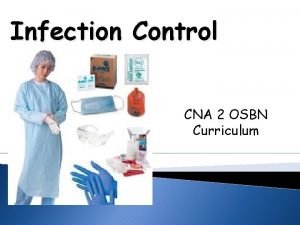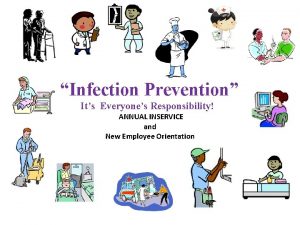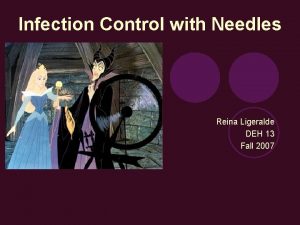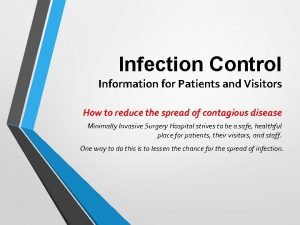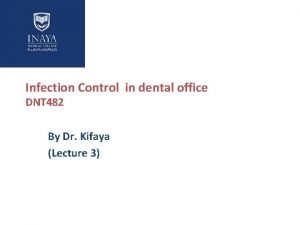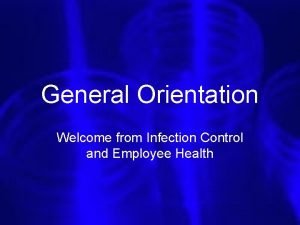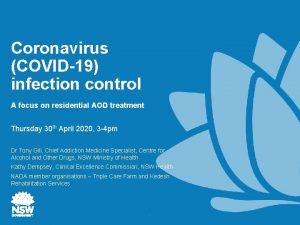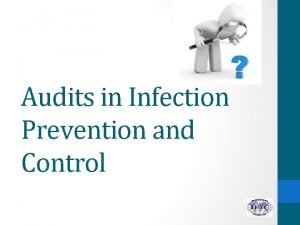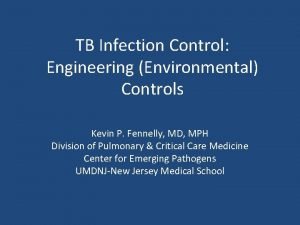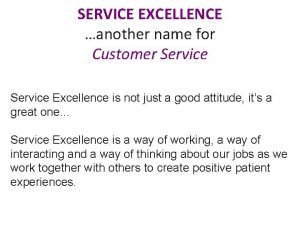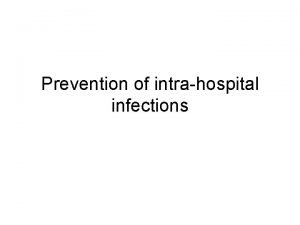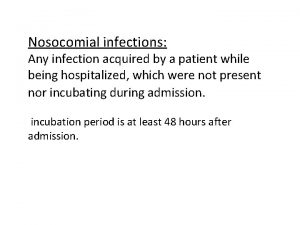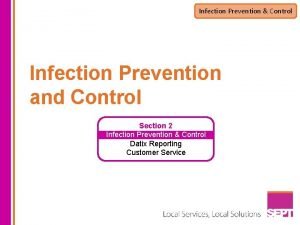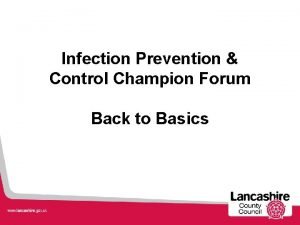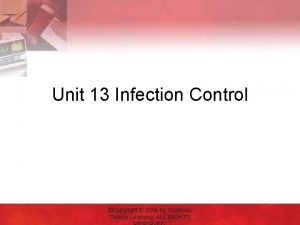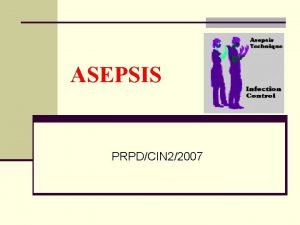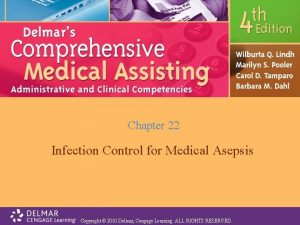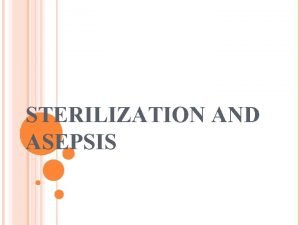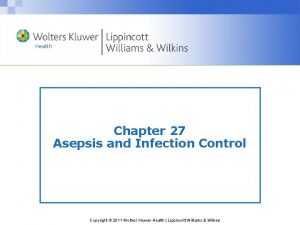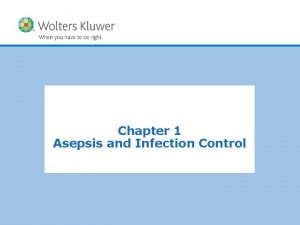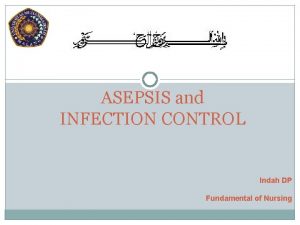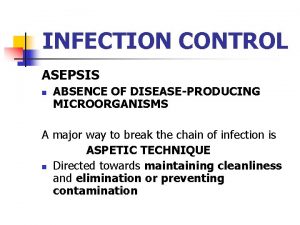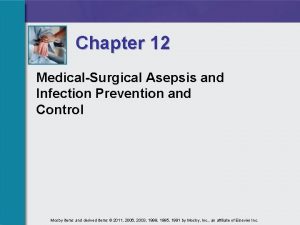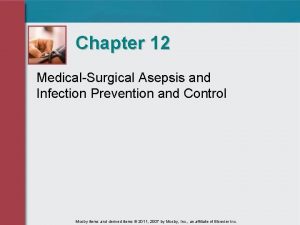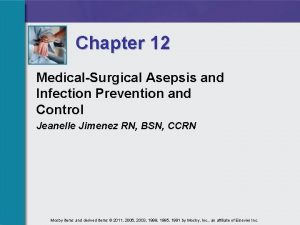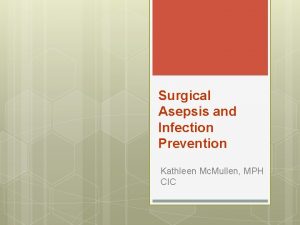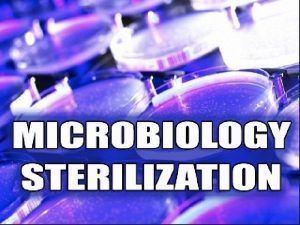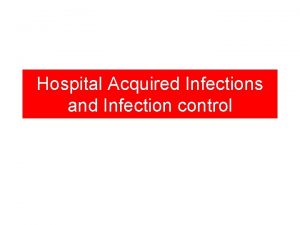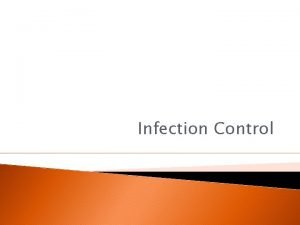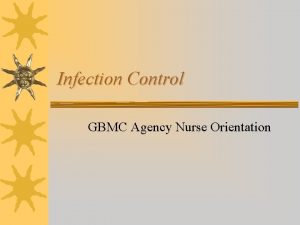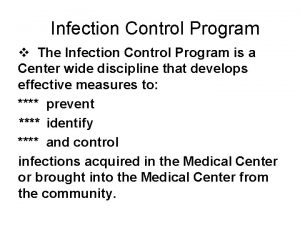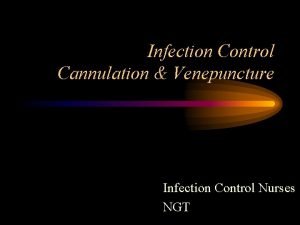Chapter 22 Infection Control and Medical Asepsis 2014


































- Slides: 34

Chapter 22 Infection Control and Medical Asepsis © 2014 Cengage©Learning. 2014 Cengage All Rights Learning. Reserved. All Rights May not Reserved. be scanned, May not copied be scanned, copied or duplicated, or or posted duplicated, to a publicly or posted accessible to a publicly website, accessible in wholewebsite, or in part. in whole or in part.

Impact of Infectious Diseases • Discovery of germ theory: Louis Pasteur and Robert Koch • Pharmacologic agents: antibiotics and vaccines • Edward Jenner: smallpox vaccine • Epidemiology: history, cause, patterns of infectious diseases © 2014 Cengage Learning. All Rights Reserved. May not be scanned, copied or duplicated, or posted to a publicly accessible website, in whole or in part.

Impact of Infectious Diseases • • Infection control and prevention Resistant microorganisms Bloodborne pathogen transmission Increased immunosuppressed populations • Global access • Effect infectious diseases have on lifestyles © 2014 Cengage Learning. All Rights Reserved. May not be scanned, copied or duplicated, or posted to a publicly accessible website, in whole or in part.

The Process of Infection • Caused by pathogenic microorganisms capable of causing disease • Normal flora • Similar steps occur in all infectious diseases • MAs must apply theory of disease growth and transmission © 2014 Cengage Learning. All Rights Reserved. May not be scanned, copied or duplicated, or posted to a publicly accessible website, in whole or in part.

The Process of Infection • Growth requirements for microorganisms – – – – Oxygen Lack of or no oxygen Moisture Nutrition Temperature Darkness Time Neutral or slightly alkaline p. H © 2014 Cengage Learning. All Rights Reserved. May not be scanned, copied or duplicated, or posted to a publicly accessible website, in whole or in part.

Infection Cycle • • • Infectious agent Reservoir Portal of exit Means of transmission Portal of entry Susceptible host © 2014 Cengage Learning. All Rights Reserved. May not be scanned, copied or duplicated, or posted to a publicly accessible website, in whole or in part.

Infection Cycle • Infectious agents – – – Viruses Bacteria Fungi Parasites Rickettsia Prions © 2014 Cengage Learning. All Rights Reserved. May not be scanned, copied or duplicated, or posted to a publicly accessible website, in whole or in part.

Infection Cycle • Reservoir – Source of a pathogen • Portal of exit – Method by which infectious agent leaves reservoir © 2014 Cengage Learning. All Rights Reserved. May not be scanned, copied or duplicated, or posted to a publicly accessible website, in whole or in part.

Infection Cycle • Modes of transmission – – Direct contact Droplet Airborne Vector • Portal of entry – Enter susceptible host © 2014 Cengage Learning. All Rights Reserved. May not be scanned, copied or duplicated, or posted to a publicly accessible website, in whole or in part.

Infection Cycle • Susceptible host – – – – Number and specific type of pathogen Duration of exposure to pathogen General physical condition Psychological health status Occupation or lifestyle environment Presence of underlying diseases or conditions Youth or advanced age © 2014 Cengage Learning. All Rights Reserved. May not be scanned, copied or duplicated, or posted to a publicly accessible website, in whole or in part.

Infection Cycle • Susceptible host – Nosocomial infection or healthcare-associated infections (HAI) – Rise of antibiotic resistant bacteria © 2014 Cengage Learning. All Rights Reserved. May not be scanned, copied or duplicated, or posted to a publicly accessible website, in whole or in part.

The Body’s Defense Mechanisms for Fighting Infection and Disease • The body’s natural barriers – Physical • First line of defense • Skin and associated accessories – Chemical • Tears, sweat, mucus, saliva, gastrointestinal secretions, vaginal secretions – Cellular • White blood cells © 2014 Cengage Learning. All Rights Reserved. May not be scanned, copied or duplicated, or posted to a publicly accessible website, in whole or in part.

The Body’s Defense Mechanisms for Fighting Infection and Disease • Inflammatory response – Response when body invaded by pathogen or physical trauma – Nonspecific response – Redness, heat, swelling, pain – Antibiotic therapy © 2014 Cengage Learning. All Rights Reserved. May not be scanned, copied or duplicated, or posted to a publicly accessible website, in whole or in part.

The Body’s Defense Mechanisms for Fighting Infection and Disease • The immune system and immunity – Protect against pathogens and abnormal cell growth – Cell-mediated immunity: attacks against viruses, fungi, organ transplants, cancer cells – Humoral immunity: antibody mediated system © 2014 Cengage Learning. All Rights Reserved. May not be scanned, copied or duplicated, or posted to a publicly accessible website, in whole or in part.

The Body’s Defense Mechanisms for Fighting Infection and Disease • The immune system and immunity – Recognition of invader – Growth of defenses; multiplication of helper T cells and B cells – Attack against infection – Slowdown of immune response after death of infectious agent © 2014 Cengage Learning. All Rights Reserved. May not be scanned, copied or duplicated, or posted to a publicly accessible website, in whole or in part.

The Body’s Defense Mechanisms for Fighting Infection and Disease • The immune system and immunity – Resistance: after exposure to pathogen; antigen– antibody reaction – Naturally acquired active immunity – Artificially acquired active immunity – Congenitally acquired passive immunity – Artificially acquired passive immunity © 2014 Cengage Learning. All Rights Reserved. May not be scanned, copied or duplicated, or posted to a publicly accessible website, in whole or in part.

The Body’s Defense Mechanisms for Fighting Infection and Disease • The immune system and immunity – Specific defenses: things that protect us against specific pathogen – Nonspecific defenses: not so particular – Immunization: provides immunity with active or passive vaccines • Live attenuated (changed) pathogens • Pathogenic toxins • Killed pathogens © 2014 Cengage Learning. All Rights Reserved. May not be scanned, copied or duplicated, or posted to a publicly accessible website, in whole or in part.

Stages of Infectious Diseases • • Incubation Prodromal Acute Acme Declining Convalescent Sequelae © 2014 Cengage Learning. All Rights Reserved. May not be scanned, copied or duplicated, or posted to a publicly accessible website, in whole or in part.

Disease Transmission • Consider each patient potentially infectious for AIDS, hepatitis B and C, other bloodborne pathogens • Apply techniques of Standard Precautions © 2014 Cengage Learning. All Rights Reserved. May not be scanned, copied or duplicated, or posted to a publicly accessible website, in whole or in part.

HIV and Hepatitis B and C • HIV and AIDS – – – AIDS caused by bloodborne virus HIV responsible for T-cell destruction Carried in semen, blood, other body fluids No curative treatment of HIV infections Antiviral drugs used to slow process © 2014 Cengage Learning. All Rights Reserved. May not be scanned, copied or duplicated, or posted to a publicly accessible website, in whole or in part.

HIV and Hepatitis B and C • Acute viral hepatitis diseases – Liver inflamed; hepatic cells destroyed – Several types of viral hepatitis – Risk for contracting HBV and HCV greater than for contracting HIV – No vaccine to prevent HCV – No treatment after exposure to prevent infection – Medication: immunomodulators © 2014 Cengage Learning. All Rights Reserved. May not be scanned, copied or duplicated, or posted to a publicly accessible website, in whole or in part.

Reporting Infectious Disease • Certain infectious diseases must be reported to state and county health departments • CDC requires information reported to them – Notifiable Disease Surveillance System • Helps CDC control spread of infection © 2014 Cengage Learning. All Rights Reserved. May not be scanned, copied or duplicated, or posted to a publicly accessible website, in whole or in part.

Standard Precautions • Blood and body fluids – Blood, secretions, excretions • Personal protective equipment – Gloves, mask, gown, goggles/face shield • Needlestick – Contaminated needles never recapped, broken off, removed from syringes, manipulated – Disposed of in approved puncture-proof container designated for sharps © 2014 Cengage Learning. All Rights Reserved. May not be scanned, copied or duplicated, or posted to a publicly accessible website, in whole or in part.

Standard Precautions • Blood – All body fluids, secretions, excretions regardless of whether they contain visible blood – Nonintact skin – Mucous membranes Personal protective equipment (PPE) >> © 2014 Cengage Learning. All Rights Reserved. May not be scanned, copied or duplicated, or posted to a publicly accessible website, in whole or in part.

Standard Precautions • Transmission-based precautions – Airborne, contact, droplet precautions – Use of barriers (gown, mask, goggles, gloves, cap) Biohazard puncture-proof sharps container>> © 2014 Cengage Learning. All Rights Reserved. May not be scanned, copied or duplicated, or posted to a publicly accessible website, in whole or in part.

Standard Precautions • Disposal of infectious waste – Items in contact with patient blood or body fluids – Place in appropriate biohazard containers – Incinerated (burned) or sterilization by autoclave © 2014 Cengage Learning. All Rights Reserved. May not be scanned, copied or duplicated, or posted to a publicly accessible website, in whole or in part.

Removing Contaminated Gloves © 2014 Cengage Learning. All Rights Reserved. May not be scanned, copied or duplicated, or posted to a publicly accessible website, in whole or in part.

Standard Precautions • Federal organizations and infection control – – – CDC: studies pathogens and diseases Standard Precautions Transmission-Based Precautions Guideline for Isolation Precautions Personal protective equipment (PPE) Respiratory hygiene/cough etiquette © 2014 Cengage Learning. All Rights Reserved. May not be scanned, copied or duplicated, or posted to a publicly accessible website, in whole or in part.

OSHA Regulations • The Bloodborne Pathogen Standard – Methods of compliance to prevent exposure • • Universal Precautions Engineering and work practice controls Personal protective equipment (PPE) Cleanliness of work areas Hepatitis B vaccine Follow-up after exposure Medical records © 2014 Cengage Learning. All Rights Reserved. May not be scanned, copied or duplicated, or posted to a publicly accessible website, in whole or in part.

OSHA Regulations • Please refer to the video library on the Instructor Resources CD to view video “OSHA Guidelines. ” © 2014 Cengage Learning. All Rights Reserved. May not be scanned, copied or duplicated, or posted to a publicly accessible website, in whole or in part.

OSHA Regulations and Students • Students with potential exposure to chemicals and bloodborne pathogens should follow OSHA safety procedures • Students do not fall under OSHA guidelines • Potential increases when invasive procedures performed © 2014 Cengage Learning. All Rights Reserved. May not be scanned, copied or duplicated, or posted to a publicly accessible website, in whole or in part.

Medical Asepsis • Hand washing • Cleaning and disinfecting contaminated surfaces • Standard and Transmission-Based Precautions © 2014 Cengage Learning. All Rights Reserved. May not be scanned, copied or duplicated, or posted to a publicly accessible website, in whole or in part.

Medical Asepsis • Disinfection • Sterilization Medical assistant sanitizing instrument>> © 2014 Cengage Learning. All Rights Reserved. May not be scanned, copied or duplicated, or posted to a publicly accessible website, in whole or in part.

Bioterrorism • Use of biologic weapons (pathogenic microorganisms) to create fear • Agents can spread through air, food, water • Can be very difficult to detect and difficult to protect against • Most dangerous: anthrax, botulism, pneumonic/bubonic plague, smallpox, tularemia © 2014 Cengage Learning. All Rights Reserved. May not be scanned, copied or duplicated, or posted to a publicly accessible website, in whole or in part.
 What is medical asepsis
What is medical asepsis Surgical asepsis hand washing
Surgical asepsis hand washing Medical asepsis definition
Medical asepsis definition Cemia medical term
Cemia medical term Chapter 16 infection control and standard precautions
Chapter 16 infection control and standard precautions Chapter 16 infection control and standard precautions
Chapter 16 infection control and standard precautions Chapter 15:9 maintaining transmission based precautions
Chapter 15:9 maintaining transmission based precautions Chapter 15:2 bioterrorism
Chapter 15:2 bioterrorism Chapter 10 infection control
Chapter 10 infection control Chapter 22 surgical asepsis
Chapter 22 surgical asepsis Infection control milady
Infection control milady Certification board of infection control and epidemiology
Certification board of infection control and epidemiology Asepsis antisepsis
Asepsis antisepsis Dental radiology ppt
Dental radiology ppt Cic certification
Cic certification Infection control meaning
Infection control meaning Infection control in dental radiology
Infection control in dental radiology Learning objectives for infection control
Learning objectives for infection control Infection control conclusion
Infection control conclusion Neutropenic precautions
Neutropenic precautions Infection control is everyone's responsibility
Infection control is everyone's responsibility Infection control
Infection control Standard precautions nsw health
Standard precautions nsw health Infection control information
Infection control information Root locus drawer
Root locus drawer Infection control orientation
Infection control orientation Infection control
Infection control Infection control audits
Infection control audits Environmental controls infection control
Environmental controls infection control Examples of service excellence in healthcare
Examples of service excellence in healthcare Infection control committee
Infection control committee Conclusion of infection control
Conclusion of infection control 10 principles of infection control
10 principles of infection control Infection control champion
Infection control champion Unit 13 infection control
Unit 13 infection control
